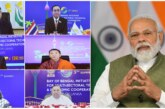World oceans encompass about three fourth of earth’s surface. According to the UN estimates, the total amount of water on earth is about 1400 million cubic kilometre which is sufficient to cover the earth with a layer of 3000 metres depth. However the fresh water constitutes a very small proportion of this enormous quantity. About 2.7 per cent of the total water available on the earth is fresh water of which about 75.2 per cent lies frozen in Polar Regions and another 22.6 per cent is present as ground water. The rest is available in lakes, rivers, atmosphere, moisture, soil and vegetation. What is effectively available for consumption and other uses is a small proportion of the quantity available in rivers, lakes and ground water. The crisis about water resources development and management thus arises because most of the water is not available for use and secondly it is characterized by its highly uneven spatial distribution. Accordingly, the importance of water has been recognised and greater emphasis is being laid on its economic use and better management.
According to broad estimates, the demand for drinking water in India is divided between the urban and rural populations, and comprises about 4-6% of total water demand. Due to the amenities of typical urban life, such as flush toilets and washing machines, people living in cities tend to lead more water intensive lives. The urban population has doubled over the past 30 years, now representing 30% of India’s total population and is expected to reach 50% of the total population by 2025.
Population growth is going to accelerate the water crisis in India, especially as more and more people move into the cities and become part of the middle class. Because the rivers are too polluted to drink and the government is unable to consistently deliver freshwater to the cities, many urban dwellers are turning to groundwater, which is greatly contributing to the depletion of underground aquifers. Rural citizens face a similar crisis. Currently 30% of the rural population lack access to drinking water, and of the 35 states in India, only 7 have full availability of drinking water for rural inhabitants. Most people who live in rural areas demand less water for day-to-day living than people living in cities, and the majority of their water demand comes from agricultural needs.
Water Quality in India
Water quality is the physical, chemical and biological characteristics of water. It is most frequently used by reference to a set of standards against which compliance can be assessed. The most common standards used to assess water quality relate to drinking water, safety of human contact and for the health of ecosystems.
In the setting of standards, agencies make political and technical/scientific decisions about how the water will be used. In the case of natural water bodies, they also make some reasonable estimate of pristine conditions. Different uses raise different concerns and therefore different standards are considered. Natural water bodies will vary in response to environmental conditions. Environmental scientists work to understand how these systems function which in turn helps to identify the sources and fates of contaminants. Environmental lawyers and policy makers work to define legislation that ensures that water is maintained at an appropriate quality for its identified use.
The vast majority of surface water on the planet is neither potable nor toxic. This remains true even if sea water in the oceans, which is too salty to drink, is not counted. Another general perception of water quality is that of a simple property that tells whether water is polluted or not. In fact, water quality is a very complex subject, in part because water is a complex medium intrinsically tied to the ecology of the Earth. Industrial pollution is a major cause of water pollution, as well as runoff from agricultural areas, urban storm water runoff and discharge of treated and untreated sewage, particularly in developing countries.
Water Quality Problems in India
The shortage of water in the country is slowly affecting the lives of people as well as the environment around them. Some of the major issues that need urgent attention are:
• As a result of excessive extraction of ground water to meet agriculture, industrial and domestic demands, drinking water is not available during the critical summer months in many parts of the country.
• About 10 per cent of the rural and urban population does not have access to regular safe drinking water and many more are threatened. Most of them depend on unsafe water sources to meet their daily needs. Moreover, water shortages in cities and villages have led to large volumes of water being collected and transported over great distances by tankers and pipelines;
• Chemical contaminants namely fluoride, arsenic and selenium pose a very serious health hazard in the country. It is estimated that about 70 million people in 20 states are at risk due to excess fluoride and around 10 million people are at risk due to excess arsenic in ground water. Apart from this, increase in the concentration of chloride, TDS, nitrate, iron in ground water is of great concern for a sustainable drinking water programme. All these need to be tackled holistically. With over extraction of groundwater the concentration of chemicals is increasing regularly.
• Ingress of seawater into coastal aquifers as a result of over-extraction of ground water has made water supplies more saline, unsuitable for drinking and irrigation.
• Pollution of ground and surface waters from agrochemicals (fertilizers and pesticides) and from industry poses a major environmental health hazard, with potentially significant costs to the country. The World Bank has estimated that the total cost of environmental, damage in India amounts to over US$9.7 billion annually, or 4.5 per cent of the gross domestic product. Of this, 59 per cent results from the health impacts of water pollution.
Role of different Agencies
Ministry of Water Resources, Ministry of Urban Development, Ministry of Rural Development, Ministry of Environment and Forest and Ministry of Health and Family Welfare all have got different roles to play to provide drinking water of adequate quantity and potable quality to meet the health needs of the community. All of them are involved and play their respective roles to provide quality water and its management. But as things stand now not all the water being consumed by the community is of drinkable standards. Apart form coordination amongst various agencies on day-to-day basis at the local level, not all Water Quality laboratories are properly equipped to tackle the issue.
There is also a gap with regard to trained manpower. Not all the results are properly recorded and follow up corrective measures are properly monitored. A common agenda for the concerned Ministries will strengthen the Water Quality surveillance programme.
India’s water crisis is predominantly a manmade problem. India’s climate is not particularly dry, nor is it lacking in rivers and groundwater. Extremely poor management, unclear laws, government corruption, and industrial and human waste have caused this water supply crunch and rendered what water is available practically useless due to the huge quantity of pollution. In managing water resources, the Indian government must balance competing demands between urban and rural, rich and poor, the economy and the environment. However, because people have triggered this crisis, by changing their actions they have the power to prevent water scarcity from devastating India’s population, agriculture, and economy. The issues surrounding India’s water scarcity mainly include demand and supply, management, pollution, impact of climate change, solutions the Indian government is considering, need for public-private partnership in water sector, water as part of corporate social responsibility etc.
India Water Hub
The National Water Policy, 2002 (NWP-2002) India, highlights the importance of water as “a scarce and precious national resource to be planned, developed, conserved and managed as such and on an integrated and environmentally sound basis keeping in view the socio-economic aspects and needs of the States.”
The NWP 2002 further identifies water as one of the most crucial elements in developmental planning. This necessitates an integrated and multi-disciplinary approach to the planning, formulation, clearance and implementation of projects, including catchment area treatment and management, environmental and ecological aspects, the rehabilitation of affected people and command area development. The development and overexploitation of groundwater resources in certain parts of the country have raised the concern and need for judicious and scientific resource management and conservation. Drinking water needs are also required to be taken in to considerations for which the NWP has attached the first priority. All these concerns need to be addressed on the basis of common policies and strategies.
The total water resources available in India has been assessed to be 1869 BCM (billion cubic meters) out of which 1123 BCM are utilizable. This includes 690 BCM from surface water and 433 BCM from ground water sources. While the total water resource availability in the country remains constant, the per capita availability of water has been steadily declining due to population growth placing India just above the water stressed condition (i.e.1700 cubic meters per capita). Therefore, there is a need for judicious utilization of this scarce natural resource in India for long-term sustainability.
Keeping in view the fact that a large number of Central and State institutions are involved in various water-related activities, there is a need to enhance their capacities towards sustainable water resource development and management in an integrated manner. In this regard the capacities of the stakeholders on the demand side viz. Panchayats, WUAs including civil societies are also required to be enhanced. Science and technology and training have to play important roles in water resources development and management in general. For this, dissemination, knowledge sharing and studies are a must. There is lot of traditional wisdom in the water sector which needs to be absorbed keeping in view the regional perspective. Many national and international organizations are working in the water sector which has, to their credit some or the other success stories/ best practices which could enhance the knowledge base to be disseminated to the stakeholders.
Keeping in these urgencies, the Ministry of Water Resources, Government of India, has decided to establish India Water Hub, which will serve as a platform where the data/ information, technological advancements, knowledge, best practices/ success stories in the water sector could be networked and disseminated to stakeholders. It would also be a learning place for the people of various age groups. Emphasis would be, not to duplicate the work being done by other organizations but to have a holding structure with uniqueness to bring technology, learning and networking in the water sector under one roof which should be able to attract the planners, scientists, engineers and all other stakeholders i.e. farmers, industries, NGOs, VOs, WUAs etc. The above platform can be provided by setting up of a National Water Hub at New Delhi. The activities of the Hub would also be decentralized by having zonal constituents in various States, keeping in view the regional requirements.
While acting as a “Centre of Excellence” for bringing the professionalism and competence in respect of various stakeholders in the water sector, the India Water Hub will inter-alia cater to the following needs of the water sector:
1. To provide a platform to the water professionals and stakeholders to interact, exchange technologies, experiences and ideas and facilitate replication of best practices in the country.
2. To map the technologies being developed in close partnership with in-house R&D experts, national and international academia and industry players.
3. Networking with various National and International bodies working in water sector.
4. To keep inventory of professionals and experts in the field of water resources for facilitating their contributions in the sector.
5. To map and consolidate the traditional wisdom available in the country for replication keeping in view regional requirements.
6. To provide policy recommendations to the Central Government and the States on sustainable development and management of water resources.
7. To facilitate development of curricula for various courses in water sector and organise capacity-building programmes for various stake holders .
8. To develop systems and procedures for benchmarking of various services in water sector.
9. To facilitate dissemination of water related data from the Government agencies/organizations for use by the stakeholders.
10. To document relevant information pertaining to water.
11. To organize and promote conferences, seminars, lectures and public debate and exhibitions in the matter of sustainable development and management of water resources.
12. To promote regional centers at convenient locations to promote these objectives.
13. To facilitate awareness campaigns highlighting the importance of water in order that the knowledge and wisdom in the sector is percolated to the grassroots level.
The IWH will act as a “Centre of Excellence” for bringing the professionalism and competence in respect of various stakeholders in the water sector. The India Water Hub, having its headquarters in New Delhi, will be up scaled after an outcome assessment. Simultaneously efforts will be made to establish Zonal centres of the HUB with the assistance of the concerned State Governments which will be networked to the main HUB in order to provide the facilities throughout the country. Subsequently, depending upon the availability of land, a water theme park could also be set up in Delhi having different games, slides, cascades, boating facilities, laser guided fountains etc to attract persons of various age groups which not only be an entertainment centre but also cater towards education of masses about the water sector. The Hub will also be networked with reputed National organizations as well as other Ministries dealing with water and International bodies like Asia- pacific Water Forum, International Water Management Institute, International Commission of Irrigation and Drainage, FAO Water Development and Management Unit, World Bank, Asian Development Bank, UNEP, UNESCO, WHO etc including the Water Hub at Singapore.
Gradually India Water Hub will emerge as a Regional Water Hub catering to the water-related interests of the countries of South and Southeast Asia.
Towards a Regional Hub
The success of India Water Hub within the country to tackle the water-related problems will lead it to address water-related issues with India’s neighbours in South and Southeast Asia. The Himalaya and Tibet Plateau are the main resources of water from where great rivers originate and flow into the countries like India, Nepal, Bangladesh, Myanmar, Thailand, Cambodia, Vietnam and others. This help can serve as a common platform for these countries to jointly address their water-related problems under one roof and negotiate the issues through peaceful means.
Issues pertaining to Climate Change and Water sector should be kept out of politics and priority should be accorded to solve them by rising above petty political considerations. While India is dependent on some of its neighbours like China for water resources located in Tibet and some of India’s neighbours like Bangladesh and Pakistan are dependent on India for their water requirements. If politics overwhelms water-related issues, then both India and its neighbours are bound to suffer acute shortage of water. It is in this backdrop that the notion of keeping water out of politics acquires significance. It is here that the role of regional hub attains importance.
Keeping in view the strategic significance of Tibet, an Autonomous Region of China, wherefrom many rivers of North India originate, this author sent a detailed note in October 2009 to various ministries of the Government of India with a plea to resolve water issue with China. This was the period when developed countries, particularly the European Union and the United States, were pressing India and China for more concessions in emission of greenhouse effects in view of the forthcoming Copenhagen Summit on Climate Change. The author has circulated similar notes on Nepal and Bangladesh to various ministries of the Government of India with emphasis on urgency for resolving water-related issues with Nepal and Bangladesh.
Dr Arvind Kumar, *President, India Water Foundation, New Delhi.



